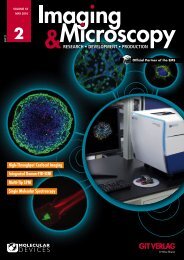SIM0216
You also want an ePaper? Increase the reach of your titles
YUMPU automatically turns print PDFs into web optimized ePapers that Google loves.
SCANNING PROBE MICROSCOPY<br />
Fig. 2: (a) Schematic of a four-point measurement on a nanowire. (b) SEM<br />
image of a freestanding nanowire contacted by three tips. The STM tips act like<br />
the test leads of a multimeter, however, contacting objects at the nanoscale.<br />
Fig. 3: Potential map measured on a Si surface with the main potential drop<br />
occurring at the atomic step edges. The current flows from the top to the<br />
bottom in this image (image size 0.5 µm).<br />
Fig. 4: Anisotropy of the surface conductivity of the Si(111)-7x7 surface. (a)<br />
Schematic of the square four-point configuration with the steps on the<br />
surface indicated by the diagonal lines. (b) Four-point resistance measured<br />
as function of the rotation angle. The resistance is low if the current is<br />
directed parallel to the step edges, while it is large when the current is<br />
perpendicular to the step edges.<br />
the contacting of nanostructures is to use<br />
the tips of a multi-tip scanning probe microscope,<br />
in analogy to the test leads of a<br />
multimeter used at the macroscale. The<br />
advantages of this approach are: (a) Flexible<br />
positioning of contact tips and different<br />
contact configurations are easy to<br />
realize, while lithographic contacts are<br />
permanent. (b) in situ contacting of “as<br />
grown” nanostructures still under vacuum<br />
allows to keep delicate nanostructures<br />
free from contaminations which can be induced<br />
by lithography steps performed for<br />
contacting. (c) Probing with sharp tips can<br />
be non-invasive (high ohmic), while lithographic<br />
contacts are invasive (low ohmic).<br />
In order to use a scanning tunneling<br />
microscope (STM) [1] for electrical measurements<br />
at nanostructures, more than<br />
one tip is required. Thus, we developed<br />
an ultra-stable multi-tip instrument<br />
which gives access to the above outlined<br />
advantages in nanoprobing [2]. This is in<br />
accord with the recent paradigm shift in<br />
scanning probe microscopy which transforms<br />
from “just imaging” to extended<br />
measurements at the nanoscale.<br />
Multi-Tip Microscope<br />
The instrument (fig. 1) comprises four<br />
scanning units allowing for a completely<br />
independent motion of all four tips. A<br />
scanning electron microscope (SEM) image<br />
of the four tips brought close to the<br />
sample under study is shown in the eyecatcher<br />
image of this article. Imaging<br />
with the secondary electrons leads to a<br />
shadow effect (dark shadow image of the<br />
tip apex) giving access to the tip sample<br />
distance. Recently, a startup company<br />
[4] has been founded which offers this<br />
instrument. In the following, we demonstrate<br />
the capabilities of the instrument<br />
for nanoscale charge transport measurements<br />
by presenting some examples.<br />
Resistance Profiling along Nanowires<br />
As a first example, we present nanoscale<br />
resistance mapping along freestanding<br />
GaAs nanowires with a diameter of ~100<br />
nm [5], which are still “as grown” upright<br />
and attached to the substrate. The schematics<br />
in figure 4a, and in an SEM image<br />
in figure 4b shows three tips brought into<br />
contact with a nanowire, realizing a fourpoint<br />
resistance measurement.<br />
In the STM based approach of nanocontacting,<br />
four-point measurements<br />
can be performed not only in one single<br />
configuration, as it is the case for the<br />
lithographic approach, but many configurations<br />
can be measured by moving<br />
the tips along the nanowire (a movie of<br />
this can be accessed in the web [4]). In<br />
this way we can measure a resistance<br />
profile along the nanowire with 50 data<br />
points.<br />
Potential Maps<br />
Another method giving valuable insight<br />
into the charge transport properties<br />
of nanostructures is the scanning tunneling<br />
potentiometry (STP). Nanoscale<br />
potential maps are acquired during the<br />
flow of electrical current. Implementing<br />
STP in a multi-tip setup has several advantages<br />
[6]. The potential resolution is<br />
Read more about<br />
scanning probe microscopy:<br />
http://bit.ly/IM-SPM<br />
More detailed version of this article:<br />
http://bit.ly/multi-tip-spm<br />
[1]<br />
All references:<br />
http://bit.ly/IM-Voigtlaender<br />
32 • G.I.T. Imaging & Microscopy 2/2016



